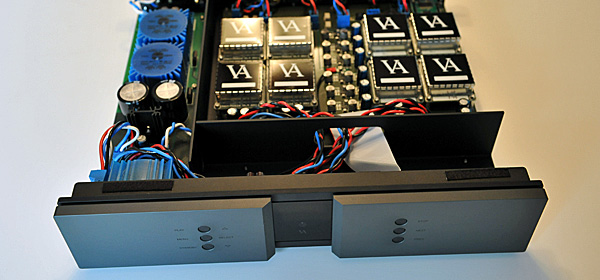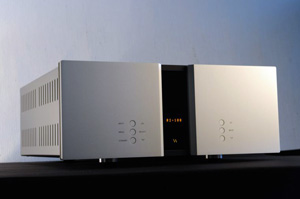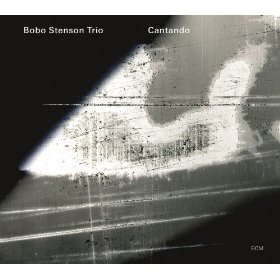Vitus Audio RD-100 DAC and RS-100 Stereo Amplifier
A Serious Reference
 Readers of my reviews over the past few years know that I have been particularly smitten with works of Hans-Ole Vitus the founder and chief designer of the components of Vitus Audio. While I have filled numerous pages with my admiration for the astounding level of craftsmanship and sonic virtues of the Vitus gear I have also bemoaned the extraordinarily high price of the typical Vitus component. That is until last year when they unveiled the new and strangely named “Reference Series” line of components.
Readers of my reviews over the past few years know that I have been particularly smitten with works of Hans-Ole Vitus the founder and chief designer of the components of Vitus Audio. While I have filled numerous pages with my admiration for the astounding level of craftsmanship and sonic virtues of the Vitus gear I have also bemoaned the extraordinarily high price of the typical Vitus component. That is until last year when they unveiled the new and strangely named “Reference Series” line of components.
I say “strangely” named because usually when you think of a company’s reference line of components they’re referring to their cost-no-object, state-of-the-art, we-just-can’t-build-it-any-better line of components. But in the Vitus case the Reference Series components are actually their entry-level, least-expensive, we-just-can’t-build-it-any-cheaper line of components.
But unlike most companies’ so called entry-level products, the Vitus Audio Reference Series products are truly reference quality products in every sense of the word. This became obvious to me when I received the first component from the Reference Series, the 300-watt RI-100 integrated amp. I was so taken with its combination of power, musicality, and bullet-proof build quality that I made it the centerpiece of my reference system.
Now they have released two more Reference Series components, the RD-100 DAC/linestage and the RS-100 stereo power amplifier and suddenly my notion of the difference between entry-level and reference quality products has been turned on its ear and the future of my reference system has become clouded. Could I actually be on the cusp of an unimaginably good sounding reference system with components that are not even its designer’s best efforts? Read on.
The RD-100
The RD-100 is a DAC and linestage in a single chassis. It features a fully analog volume control and fully analog balanced (XLR) and unbalanced (RCA) inputs. There are also a full suite of digital inputs and outputs. Vitus himself told me that when the analog inputs are in use the digital circuitry is defeated resulting in fully analog linestage operation. The DAC supports files up to 32bit and 192kHz sampling.
The look and construction quality of the RD-100 is classic Vitus. The elegantly styled front panel holds the full array of soft-touch control buttons and has the LED display in the middle that shows the volume level, input selection and menu functions. The rear panel features six digital inputs: USB, optical, (2) coaxial, and (2) AES/EBU. There are also a set of analog RCA and XLR inputs. That should be more than enough connections to satisfy any system. After market power cords can be used via the IEC receptacle and there’s even an Earth/ground contact available. As with other Reference Series components the RD-100 also uses an Apple remote control, which is actually more functional than I originally thought. Considering its lineage, this may well be the biggest bargain product Vitus has yet produced. I know, I know, $14K is hardly cheap, but when you consider what a Vitus quality linestage and DAC would cost separately…
I thought the mantle of “biggest Vitus bargain” (try saying that three times fast) product would belong to the RI-100, but that was assuming the inclusion of both a phono and DAC module within that chassis. But those modules have yet to be produced and if you subscribe to the belief that the linestage is the most important link in the amplification chain, consider that the RD-100’s linestage section is considerably better than that in the RI-100. I’ve used both to drive the same system. Hans-Ole estimated that the linestage of the RI-100 is only about 80% of the RD-100.
The RS-100
Now let’s move on to the RS-100. This will probably be the “Rodney Dangerfield” product in Vitus Audio’s Reference Series. In all honesty it’s simply a big, beefy 300-watt Class-A/B stereo amp, and these days there is certainly no shortage of high-powered Class-A/B stereo amps on the market. It’s built in the same chassis as the RI-100, which is to say that it is sized somewhere between the great SM-010 (my favorite Vitus amp) and the massive SM-101. Like all Vitus amps it features modular construction and custom-made transformers. It also uses both balanced (XLR) and unbalanced (RCA) inputs and heavy-duty five-way speaker posts. The quality of build is of course, impeccable and operation is idiot-proof with only a “STANDBY” button for putting the unit into operating mode and an “INPUT” button to toggle back and forth between using the amp’s XLR or RCA inputs. But considering that it’s only $500 less than the likes of the 600-watt Classe’ Audio CA-M600 mono amps that I reviewed back in October of 2011, you might even say that it’s overpriced even by Vitus standards. You might say that… unless you’ve heard the synergistic way that the RS-100 combines with the RD-100. Time to talk about my listening sessions.
 System Setup and Listening
System Setup and Listening
Let me begin by talking about the system that was used to evaluate these components. Over the past several months the Magnepan MG20s were my primary speakers for evaluation listening. They were being driven by a pair of Bel Canto’s M300 mono amps on the tweeter/midrange drivers and REF1000M monos on the woofers via a Bryston 10b electronic crossover. When the Vitus gear arrived I placed the RS-100 on the tweeter/midrange and the RI-100 (bypassing the linestage section) on the woofers. The RD-100 was used as my DAC and linestage. The main source was an OPPO Digital DV-980H disc player (used as a transport) and an Apple TV digital streaming device.
Sadly, the Bryston died after only a couple of brief listening sessions, hardly enough time to make a proper evaluation. So I had to get another pair of worthy speakers in house that I could get comfortable enough with in my system to use for evaluation. Enter the Sonic Hemisphere Fidelity One loudspeakers (Around $5,000/pair. Review coming).
This worked out famously because I was able to simplify the system by just using the RD-100 and RS-100 without having to consider the impact of using an electronic crossover and four channels of amplification. The Fidelity One speakers are very neutral sounding which makes them ideal for system evaluation. I spent a couple of weeks listening to them connected to the RI-100 just to get the proper attitude to begin my listening with the Vitus separates in place. Finally, I was now ready to get to work.

I began listening to CDs feeding the RD-100’s coaxial digital input. I popped open a couple of discs that I bought during the recent AXPONA show in Chicago. The first disc was the Bobo Stenson Trio’s Cantando [ECM]. This disc is loaded with wonderful piano jazz that is layered with delicate chimes, lite percussions and of course some brilliant and deeply moving piano work. Track 4, “M” is particularly lovely, and rendered by the Vitus combo is one of those rare tracks that immerses you in the performance. It wasn’t quite as emotionally involving as Vitus’ own SM-010 Class-A mono amps that I reviewed back in 2010, but few amps are. Still, it was a really nice combination of sweetness and authority that I believe most audiophiles look for in a high-fidelity music system.
Next, I wanted to see how live music would be treated by this very neutral sounding rig. So I put on guitarist Kurt Rosenwinkel’s, The Remedy: Live at the Village Vanguard [WOMMUSIC]. This two disc set really made the most out of the RS-100’s beefy 300 watts. Track 2 of disc 2, “Terra Nova” features a very pleasing piano performance by Aaron Goldberg early on in the song. It’s during this performance that you get a wonderful sense of the intimacy of the performance and venue. The piano comes from such a deep and dark backdrop that when the solo ends and the applause come down, it’s nearly jarring because you are so drawn into the music.
 Shifting over to my iTunes library using the Apple TV music streamer into the RD-100’s optical input, I wanted to experience vocal performances from my new favorite female singer, the dreamy voiced Gretchen Parlato. The Lost and Found [Obliq Sound] is her most recent album and I dare say you won’t find a single song on it that you won’t enjoy. The first track is a fantastic cover of Simply Red’s “Holding Back the Years.” Parlato’s voice is an interesting combination of wispy, soulful, sensuality. She damn-near moans half the lyrics, and I don’t mean that in a bad way. While it is important to have an amp that can pour every note of music into your speakers, it is equally important to have a control unit capable of transporting every undistorted particle of sound from your sources to the amplification. This is where the Vitus combo is at its most synergistic. As enchanting as Parlato’s voice is to listen to, the thing that really captivated me was just how bad-ass her band is. Track 13, “Blue In Green” is a song that does not waste any of its ample rhythm, and this system does tremendous justice to its many dynamic pace changes and cymbal crashes. Detail, sparkle, slam, detail! The same goes for track 15, “How We Love.” I cranked this puppy up to nearly live music levels and the system never lost its composure or musicality. That’s a pretty neat trick for an entry level system. But then again, Vitus Audio is no ordinary company.
Shifting over to my iTunes library using the Apple TV music streamer into the RD-100’s optical input, I wanted to experience vocal performances from my new favorite female singer, the dreamy voiced Gretchen Parlato. The Lost and Found [Obliq Sound] is her most recent album and I dare say you won’t find a single song on it that you won’t enjoy. The first track is a fantastic cover of Simply Red’s “Holding Back the Years.” Parlato’s voice is an interesting combination of wispy, soulful, sensuality. She damn-near moans half the lyrics, and I don’t mean that in a bad way. While it is important to have an amp that can pour every note of music into your speakers, it is equally important to have a control unit capable of transporting every undistorted particle of sound from your sources to the amplification. This is where the Vitus combo is at its most synergistic. As enchanting as Parlato’s voice is to listen to, the thing that really captivated me was just how bad-ass her band is. Track 13, “Blue In Green” is a song that does not waste any of its ample rhythm, and this system does tremendous justice to its many dynamic pace changes and cymbal crashes. Detail, sparkle, slam, detail! The same goes for track 15, “How We Love.” I cranked this puppy up to nearly live music levels and the system never lost its composure or musicality. That’s a pretty neat trick for an entry level system. But then again, Vitus Audio is no ordinary company.
Conclusion
Frankly, I don’t think Hans-Ole is capable of making what most people would call an entry level product. And even if that wasn’t true his lovely and tough-as-nails production manager wife, Britta sure as heck wouldn’t let him. Believe me, I’ve met the woman and knowing her tells the true story behind the success of this company. If it isn’t of the highest quality of finish and performance it won’t have the Vitus name on it.
Of the two, the RD-100 is the component that dazzled me the most. The high-level of flexibility and input and output options, makes it more of an every-man’s type component (as long as every-man is extremely well-heeled) but with the lofty pedigree for those of upper-crust sensibilities. Best of all it turned my little Bel Cantos into flat out beasts! The REF1000Ms actually sounded like 500-watt amps should. Cojones Grande!
But this is not to say that the RS-100 is not a splendid amp, it most certainly is. I could be extremely happy with it anchoring my reference system ‘til the end of my days. It will more than hold its own in even the loftiest systems. But the RD-100 just has that something special about it and has made an indelible impression on me. Pair it with the RS-100 you have a state-of-the-art DAC/Linestage and 300-watt amp for $27K that gives you one hell of a slice of the ultimate high-end. Isn’t that what we are seeking from this thing of ours?
Even though these components may represent Vitus Audio’s “entry level” they are called “Reference Series” for good reason. The quality of design and construction are first rate and sonically they give you a massive portion of what you get from their larger, more expensive siblings. Considering just how much music that actually is, these components may end up being the best value of all the Vitus product lines. Highly recommended.


Specifications
RS-100 Stereo Power Amplifier
Rated Output Power: 2 x 300Wrms in 8 ohm Class AB
Outputs: 1 set of speaker outputs
Inputs: 1 balanced (XLR), 1 unbalanced (RCA)
Dimensions (H x W x D): 180x435x430 mm
Weight: 42Kg
Price: $13,500.00
RD-100 DAC/Linestage
Digital Inputs: (2) XLR, (2) RCA, USB, TOSLINK
Analog Inputs: (2) XLR, (2) RCA
Analog Outputs: XLR, RCA
Digital Audio Input:
Resolution: 24 Bit
Sample Rate: 32-192 Khz
Volume Control: Relay controlled fixed resistor network. Gain: -99 to +12 dB
Power Consumption: 30 watts RMS (Standby/Operation)
Dimensions: (H x W x D) 100 x 435 x 377 mm
Weight: 9 Kg
Price: $14,000.00
Address:
AVA Group A/S
Sandgaardsvej 31
DK-7400 Herning
Denmark
Phone: +45 9626 8046
FAX: +45 9626 8045
Website: www.vitusaudio.com
Email: info@vitusaudio.com
Stereo Times Masthead
Publisher/Founder
Clement Perry
Editor
Dave Thomas
Senior Editors
Frank Alles, Mike Girardi, Russell Lichter, Terry London, Moreno Mitchell, Paul Szabady, Bill Wells, Mike Wright, and Stephen Yan,
Current Contributors
David Abramson, Tim Barrall, Dave Allison, Ron Cook, Lewis Dardick, John Hoffman, Dan Secula, Don Shaulis, Greg Simmons, Eric Teh, Greg Voth, Richard Willie, Ed Van Winkle, and Rob Dockery
Site Management Clement Perry
Ad Designer: Martin Perry





Be the first to comment on: Vitus Audio RD-100 DAC and RS-100 Stereo Amplifier